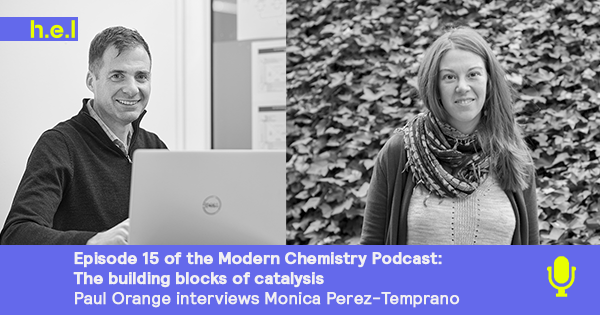Monica Perez-Temprano
The building blocks of catalysis

Episode 15 of the Modern Chemistry podcast is a deep discussion with Monica Perez-Temprano about studying the mechanisms of catalytic processes.
Monica Is a group leader at ICIQ (Institut Català d’Investigació Química / Institute of Chemical Research of Catalonia), Tarragona, Spain. Her group focuses on the ‘Development of new chemical transformations:
Our theme music is “Wholesome” by Kevin MacLeod
Music from Film Music
License: CC BY
Connect with me (Paul) on LinkedIn.
From organometallic mechanistic studies to catalysis’. Prior to her current position, Monica conducted postdoctoral research at the University of Michigan, Ann Arbor, USA, which followed awarding of her Ph.D. from the University of Valladolid, Spain – where she also earnt her B.Sc. and M.Sc.
In 2018, Monica was selected as one of the ‘Talented 12’ by Chemical & Engineering News (C&EN), the American Chemical Society (ACS) weekly news magazine. She is also involved in outreach activities to increase the visibility of women in Science.
Terms used during interview
- NMR – Nuclear Magnetic Resonance subjects samples to strong magnetic fields and measures the resonance pattern of the nuclei. It is widely used to study the structure and dynamics of organic molecules.
- Palladium – A chemical element with atomic number 46. It is a rare metal, and over 50% of palladium supply is used in the catalytic process, most commonly catalytic converters attached to automobile exhausts.
- Cobalt A chemical element with atomic number 27. Most commonly produced as a by-product of Copper and Nickel production, the main use for cobalt is in Li-ion batteries and the production of certain high-strength metal alloys.
- Transition metal – in chemistry, the term transition metal is defined in one of three ways:
- Many scientists describe a “transition metal” as an element in the d-block of the periodic table, which includes groups 3 to 12 on the periodic table. In practice, the f-block lanthanide and actinide series are also considered transition metals and are called “inner transition metals.”
- The IUPAC definition defines a transition metal as “an element whose atom has a partially filled d sub-shell, or which can give rise to cations with an incomplete d sub-shell.”
- The expanded IUPAC definition specifies which elements are included. As well as the elements of groups 4 to 11, scandium and yttrium are included. Lanthanum and actinium, considered group 3 elements, are classified as lanthanides and actinides, respectively.
- Nucleophile – A chemical species that forms bonds with electrophiles by donating an electron pair.
- Oxidant – A substance that can oxidize another substance. In chemical reactions, this refers to the oxidant accepting electrons.
- Intermediate – A chemical entity formed during a reaction, but that is typically converted to another form when the reaction completes.
If you want to know more information or see the publications Monica mentions in the podcast, you can visit the group website. Alternatively, you can find her on LinkedIn and Twitter.


